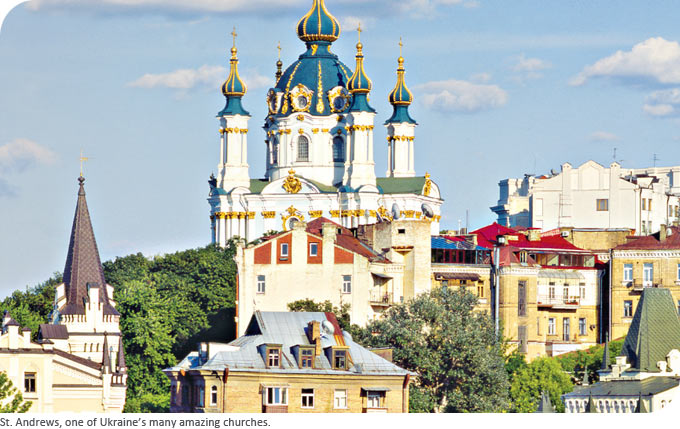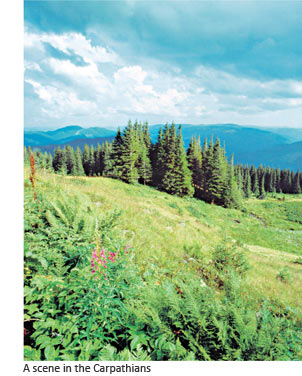
 o, this article is not planned as a list of travel agents, hotels and destinations. Rather it is a snapshot of where Ukraine tourism stands today. o, this article is not planned as a list of travel agents, hotels and destinations. Rather it is a snapshot of where Ukraine tourism stands today.
It is not a bad idea to start this account at the State Service for Tourism and Resorts. This rather noble-sounding institution is housed in a ramshackle, central Kyiv building which has seen few if any improvements since its Soviet days. Scuffed floors and walls, the latter adorned here and there with fading photographs of some of Ukraine’s lovely sights, bespeak an old and tired institution.
Not so the man working to bring about change to the tourism sector in Ukraine. Sergiy Siomkin, deputy chairman of the State Service, exudes energy. Speaking through a translator, he admits that Ukraine has a very long way to go in raising the standards of its tourism and hospitality industries to international levels, but he sees a huge potential for his country’s tourism sector.
He lists some of the problems: a lack of good highways and railways (the only bit of European-standard highway in the whole country is that connecting Borispol, Kyiv’s main airport, with the city itself), a mixed bag of facilities ranging from top-of-the-line luxury hotels to Soviet-era holiday destinations that remain largely undeveloped and offer services notable for their poor quality.
But if that is the picture of the bad, and yes, sometimes the ugly (few believe Soviet architecture offers contributions to aesthetics for the ages), the good lies in Ukraine’s huge tourism potential.
This is a country of mountains and forests, rich agricultural lands and a coast that beckons in the summer. It is a country rich in culture and history, dotted with some of the world’s most magnificent churches and monasteries, castles, palaces and forts.
 To the west lie the lovely Carpathian mountains, anchored by notable cities such as Lviv – for centuries part of Poland (as Lvov) – with a town center that has largely survived centuries of war and is on UNESCO’s World Heritage list, and Chernivtsi where the Hapsburgs in 1875, when the town was named Czernowitz, erected a university that attracted students from a wide region. In summer the tree-clad mountains offer cool temperatures for hiking, camping and enjoyment of the region’s rich natural diversity, while in winter they provide top-rate ski slopes. To the west lie the lovely Carpathian mountains, anchored by notable cities such as Lviv – for centuries part of Poland (as Lvov) – with a town center that has largely survived centuries of war and is on UNESCO’s World Heritage list, and Chernivtsi where the Hapsburgs in 1875, when the town was named Czernowitz, erected a university that attracted students from a wide region. In summer the tree-clad mountains offer cool temperatures for hiking, camping and enjoyment of the region’s rich natural diversity, while in winter they provide top-rate ski slopes.
To the east lies the Black Sea coast, featuring Odessa and the Danube Delta region, the latter home to an amazing variety of bird species. And, of course, farther east yet, is the Crimean peninsula, long the holiday destination of tsars and communist rulers alike, as well as many “ordinary folk” from Russia seeking sun and sea.
Crimea boasts historic palaces and places steeped in history. In the Crimean War, armies of the British, French and Ottomans converged on Sevastopol in the 1850s. The battle is depicted in a panorama presentation on an elevation overlooking the city. In Bakhchisaray there is the fine Hansaray Palace built by the Crimean Tartar Khans.
Balaklava witnessed not only the Charge of the Light Brigade, but also Soviet submarines slipping into a subterranean tunnel where they remained hidden from prying eyes. While down the coast in Yalta, Joseph Stalin, Winston Churchill and Franklin Roosevelt met at Livadia, the former summer palace of the last Tsar, Nicholas, to discuss the fate of post-World War II Europe.
Mark Twain visited Crimea in 1867, writing about the region in his The Innocents Abroad. Perhaps it is time you went too?
Ukraine’s capital, Kyiv, is itself home to many of the finest churches in the country, as well as museums, art galleries and a lively, ever-more cosmopolitan lifestyle.
Another way of looking at Ukraine is through the specialized tourism it offers. There are many and various mud and mineral spas in the Carpathians, Crimea and the Odessa region. They are relatively inexpensive, Siomkin assures us. A bill before Parliament would develop some areas that lend themselves to these treatments into health resorts.
Religious pilgrims, whether Jews, Christians or Muslims, all have places of interest to visit, and this type of tourism is growing quite rapidly. So too is agro-tourism, where Ukrainians themselves are looking for ways to get back in touch with their country’s roots.
Siomkin believes that Ukraine, “probably has the best ski resorts in the world.” The ski set at Innsbruck and Gstaad might find that hard to believe, but then they probably have not yet managed to get to the Ukraine slopes. It’s the poor infrastructure and limited resort facilities that are holding the winter sports sector back.
Siomkin notes that poor infrastructure often translates into higher prices, because service providers have to spend more to be able to offer those services. By way of an example, he points out that Russians and Ukrainians are used to paying above average prices in places like Crimea, but tourists from elsewhere are probably surprised at the rates, especially “since it might be hard finding a toilet,” as he puts it.
In an effort to get the word out to the world, Siomkin has led three delegations to major tourism fairs in Japan, England and Spain, and ad campaigns have run on CNN International and BBC World.
Despite his enthusiasm for developing tourism in Ukraine, however, Siomkin has few marketing materials to help his cause. For example, he has no database of digital images showing Ukraine’s attractions. Printed materials are very limited, the best in English being a booklet Traveling in Ukraine, published in 2008 to feature the Seven Natural Wonders of Ukraine, as chosen by a nation-wide survey.
A video called Ukraine Invites features many attractive scenes, but the editing offers almost continuous split screens, undermining the point of presenting Ukraine’s beauty to the world.
Speaking of Ukrainian beauties, the women are known the world over for their well-deserved reputation as lovely representatives of their sex, and attract a constant flow of male visitors from far and wide. The general friendliness of the people is also an asset for developing the hospitality industry.
There seem to be no reliable statistics on tourist numbers, expenditures and the like. Rather, the total number of visitors is counted, regardless of the purposes of their visits. These counts have averaged 20 million a year for the last three years. Russians are by far the largest group, followed by Moldovans, Belorussians, Poles, Romanians, Hungarians, Slovaks, Germans, Americans and Uzbeks.
To help address the bad in Ukrainian tourism, a bill was passed offering a 10-year tax holiday for any company that can put up a hotel by January 1, 2012. That date is significant because later that year Ukraine will co-host (with Poland) the Euro Cup soccer competition, which will attract hundreds of thousands of visitors and millions of viewers worldwide.
More incentives for investors in the sector are on the way, Siomkin says, and a key part of this government’s agenda is to aggressively seek foreign investment for infrastructure projects and tourism developments.
The ugly is largely being replaced incrementally, as cheap Soviet-era structures give way to better replacements. Perhaps the State Service for Tourism and Resorts will itself be assigned to offices more indicative of a bright future instead of a drab past.
There is no doubt that Ukraine has a great tourism potential. It will be interesting to see how that potential is developed in the future. If the transformation that has swept the country since independence takes hold more widely in the tourism sector, the results are bound to be very good indeed.
|